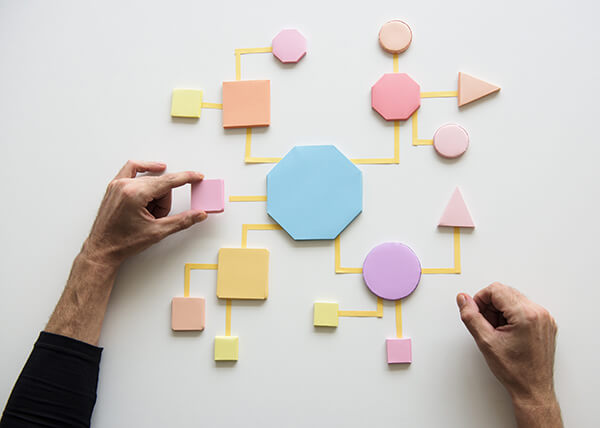How do you turn a novel idea into an instant success and attain the highest levels of customer satisfaction when launched in the market?
Two-words; Design Thinking!
In today’s extremely transformative and competitive environment, making a breakthrough encompasses an array of evolving complexities that traditional methods of development cannot fathom. A world where Ideas are quickly phased-out for a more versatile version and human expectation match the pace of technological disruption.
Design thinking is a human-centered approach to discovering the next big innovative solution or building on your existing product.
According to Stanford University professor and founder of design firm IDEO, David Kelley defined Design Thinking as:
“A human-centered approach to innovation that draws from the designer’s toolkit to integrate the needs of people, the possibilities of technology, and the requirements for business success.”
Design thinking is not focused on appearances but is a method to combine creativity, customer needs, technology, and flexible solutions to create products that fit into users unmet or unarticulated needs – directly filling a void.
The model of design thinking can be applied to just about anything; be it an internal or external process, team management structure, finding innovative solutions, resolving an existing problem and more.
Led by multi-disciplinary teams, the initial processes lays emphasis on vicariously understanding customer’s pain-points, their feelings, desires, etc, and then defining these needs into opportunity spaces to innovate. Selected value propositions are validated through quantifiable results by rapid prototyping and further refined through iterative cycles based on collective results.
A design thinking led innovative solution is deemed worthy to be launched in the market only when it hits all the right notes – including strategic advantage, impact on business and impact on the customer.
Let us further illustrate the perks of implementing designing thinking for modern day businesses:
Customer satisfaction is paramount to success:
Putting customers first, walking in their shoes or empathizing to their needs – this is at the heart of design thinking and what drives it forward. Not some random compliment or self-gratification.
Thomas Edison didn’t conjure the electric bulb out of thin air, it was borne out of deciphering the needs of the people for a cheaper alternative to oil and gas-based lighti

ng. Though bulbs have taken many shapes and forms since; Edison’s ingenuity has enabled humans over the decades to save cost and resources.
Great innovations understand the customers; it should be a result of wide-scale feedback and research based on various factors like age demographics, profession, etc. The underlying questions should always be – Will my product alleviate a customer pains.
Bring a designers perspective to multi-disciplinary teams:
Engaging the services of multi-disciplinary teams allow you to solve a problem by looking at it from various angles – The key is to get these teams to work in cohesion – orchestrating the perfect collaboration.
What is the advantage of resolving problems from a designer perspective?
Let us look at a use-case scenario to best exemplify how designing-thinking trumps traditional methods. IBM was approached by an airliner to speed-up passenger gate check-ins by improving their kiosk functionality.
From the out-set of the project, IBM’s team of engineers went straight to work by trying to improve the kiosk software. But the designers took an unconventional approach to discover the root of the problem by interviewing gate agents, passengers, etc.
IBM eventually decided to use the designer’s inputs and build a mobile app that eased the boarding process and reduce costs.
Designers are intuitive and embrace the concept of lateral thinking with a more refined approach to immersing themselves to the needs of customers.
Complex problems are broken down to simple solutions:
Companies face multi-faceted problems in dealing with complexities posed by current market demands. To invariable push forward adapting to technological feasibility, business visibility, and human usability quotient is no mean feat.

For the customer’s standpoint “simplicity is the ultimate sophistication”.
Apple is one of the best examples of how design thinking can be imbibed to break the complexity of disruptive technology. Since his return to Apple, Steve Jobs obsession to connect innovation directly to user-experiences has allowed Apple’s range of “i” products to not only disrupt our perception of technology but to directly fit into our way of living without us realizing it.
Bring more agility to future-proof ideas:
Design thinking embeds the core -values of agile processes to deliver versatile outputs that stand the test of time. One of the key features of an agile framework is to iterate endlessly until the product takes its best shape – satisfying customers and bringing quantifiable business results.
What happens when customers and business requirements change?
Iterations continue.
Agile methodology makes certain that you reach a win-win destination even if you sway of-course; iterations get you back on track. Traditional methods usually take a fixed path that takes you straight to either a win-lose destination.
Conclusion:
We often learn more from failure more than we do from success, yet insanity is repeating the same failure over and over again deriving the same results. With design thinking as the protocol for solving existing problems and uncovering new opportunities – we may have finally found the solution to consistently winning.
